System crashed! One of the worst fears of businesses is what if their system crashes suddenly? What if the hard drive that has an enormous amount of valuable data in it corrupts suddenly? Remember the infamous JournalSpace data loss (2009) blunder. JournalSpace was a six-year-old blog hosting company that reported the operating system crash with no back-up data in place for recovery. It affected the company and hundreds of bloggers who hosted their site on JournalSpace. The company had to shut down. Spending 6 years on building a company with hundreds of bloggers on the platform to end like this is tragic. But wait, even worse, was the Microsoft Sidekick's cloud server data loss (2009) that resulted in 800 thousand customers losing their contacts, photos, email addresses, and to-do lists. It cost Microsoft a huge amount in compensation and people's faith in cloud computing was shaken to the core.
Such incidents, whether they occur due to human errors, viruses or malware, hacker activities, hard drive corruption, power outages, theft, or disasters such as fire or earthquake, point towards the need for companies to keep multiple back-ups at multiple locations for complete data security. Everyone requires some kind of back-up in life; even militaries can't do without it. Companies need to have a proper back-up strategy to restore the data in case of an adverse happening.
Disk Imaging and Disk Cloning are two ways in which businesses, large organizations, government institutions, and even individuals can keep the back-up of their valuable data. Both Disk imaging and Disk cloning serve the same purpose, with a slight difference in their methods to do so. Both have the same goal, and both have software and hardware requirements to complete the task. One deploys a disk imaging software and the other a disk cloning software.
What is Disk Imaging/Cloning?
Disk imaging is the computer system process by which an archive is created for a source disk, which can be later used for making more copies of the hard drive. In the Disk imaging process, all the data of a hard disk is copied sector-wise, including hidden files and configurations. This data is copied to another hard drive in a compressed form. It allows more than one image to be reproduced on a hard disk so that users can take back up of more than one computer into the destination disk. The image has to be restored and installed on another computer to start working. Disk imaging software creates an archive of the source disk that can be used to create a back-up copy of the source disk.

Disk Cloning is a process by which one hard drive is copied into other drives to make an exact copy of the source drive. A clone will have all the contents from the source drive, but it is not in a compressed form. Once a clone is formed, users cannot add or change data. A clone is ready to use a disk that can be inserted into any computer, and it will start working. Disk cloning software creates a clone of the source disk into another hard drive.
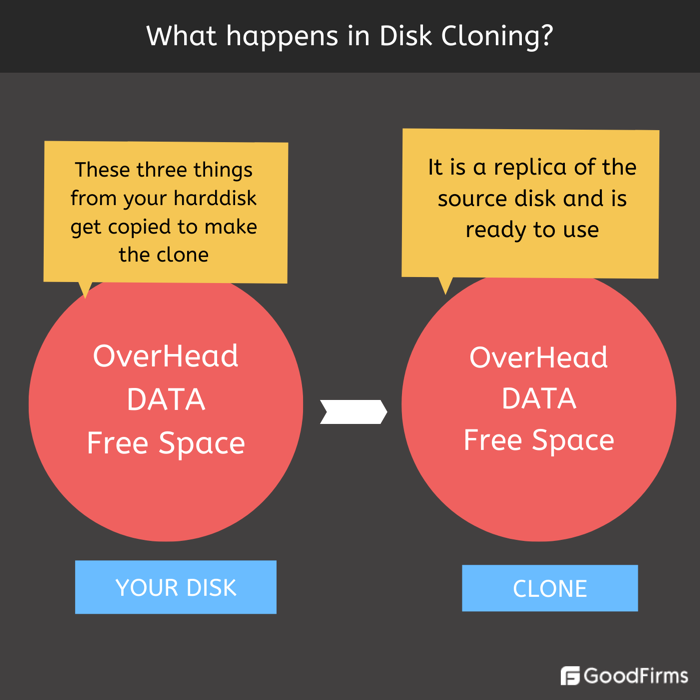
What is the difference between Disk Imaging and Disk Cloning?

Who Uses Disk Imaging Software?
- Corporate World
Small and medium-sized businesses, large scale companies, and conglomerate corporate organizations use this software for back-up and other purposes. Mostly they prefer a Disk Imaging Software that provides cloud services along with the Disk imaging or cloning service. As these companies have considerable data to monitor and store, they always require a disk imaging solution provider who takes care of the entire data section.
- Government Institutions:
Present-day Governments are creators of bulk data. The data about their various departments, branches, citizens, and sensitive defense data has to be stored carefully with multiple back-ups. These institutions use the service of a Disk imaging solution provider to create a back-up on a large scale.
- Forensics Department
The use of this software is not only limited to the corporate world, government organizations, individuals, but other entities like forensics departments and data recovery firms also use this software for various purposes. In Forensics, this is mainly used to create a back-up of electronic evidence like computer hard disks, mobile hard drives, CDs, Floppy disks, Camera memory cards, etc. As the original evidence cannot be tampered with in legal proceedings, so forensic experts first create an image and then run all the tests.
Data Recovery Firms
Data recovery firms that recover data from even damaged hard disks use high-quality disk imaging software to complete the process. Mostly these firms are employed by Government departments, the forensics department, corporates, and sometimes even individuals reach them to recover their deleted, damaged, or corrupted data.
- Individuals
Individuals in professions like chartered accountancy, specialist doctors, stockbrokers, real estate consultants, counselors, and others create data that they require to be safe and secure. Deletion or damage to such data can cost them a lot. They utilize Disk imaging and cloning software services to help them create a back-up for their data.

What are the features of Disk Imaging Software?
- Supports all file formats
A disk imaging software should be able to copy all types of files and extensions. It must also copy files that have a long name.
- High speed of work
The processes, such as disk imaging and disk cloning, take a lot of time. The kind of data that they back-up is too massive. There are chances of errors also. The software that exhibits a high level of speed to accomplish this task is always preferred.
- Encryption
Uploading data for back-up to hard drive or cloud servers comes with the risk of intrusion. The hackers and malicious viruses might try to interrupt the service or steal data during the transfer process. Most of the disk image software comes with inbuilt encryption. Encryption protects important data.
- Boot disk option
The disk image is too big and takes a lot of space. So external hard drives are used to take back up. This back-up has to be loaded back to a computer. This requires a boot disk. The boot disk is a disk or temporary set of files that are needed to install or boot a computer to load an operating system.
- OS imaging
The term means to capture the images of one system and then to replicate it on other. The whole operating system is copied by IT administrators and is run on others.
- Disk Cloning
Most of the Disk imaging software can also be deployed for disk cloning. This software will have this feature mentioned outside. Clones disks or partitions of different sizes.
- Remote Imaging
Sometimes administrators might not have physical access to computers that they want to image. Remote imaging allows imaging a distant computer remotely.
- Scheduling
Users can schedule and set the regular time intervals at which they want the disk imaging software to start disk imaging automatically. Sometimes users forget to take data back up for many days, and their data is vulnerable to lose or attack. Scheduling will ensure that data back-up keeps happening on its own at regular intervals.
- Cloud back-up
The disk imaging software has the capacity to upload data to cloud servers directly. A cloud back-up of the disk would upload the source disk data into cloud servers owned either by the disk imaging software company itself or some other third party vendor that provides cloud services. It is a practical solution to put all data into the cloud as generally, the data created by businesses is too huge for the disk drives. This happens in real-time, so in case of a system malfunction, the data is safe, and there is a negligible loss of data. Not all disk imaging software provides this service, but most of them do.
- Differential Back-up:
A disk imaging software should be able to compare two disks together and find the difference. It should then take the back-up of the difference only.
- Simple Interface
The software should not be too much complicated for users to understand. Intuitive software that is easy to use is preferred.
- Partition Management
The software manages partition related issues also. It can change the disk volume utilized by each partition of the disk.
- Incremental Back-up
The disk imaging software should also be able to take incremental back-up. Incremental back-up is an addition to the already existing back-up of a disk. If changes were made to the source disk and additional content was added, then incremental back-up would take only the newly added content for extra back-up. This makes a lot of sense.
This article lists down the 9 top free and open-source Disk Imaging Software:
- Clonezilla
- FOG
- Do clone
- Part clone
- Mondo Rescue
- AOMEI Backupper
- Macrium Reflect
- Drive image XML
- Ease us
Comparative Table of 10 Best Free and Open Source Disk Imaging Software

Clonezilla is a free and open-source disk imaging software that comes in three versions:
a. Clonezilla live, b. Clonezilla lite server, and c. Clonezilla SE (server edition). Clonezilla live is used for single computer back-up, while the Clonezilla lite server or SE is for bulk computer deployments. Its reported cloning speed is 8GB per minute.
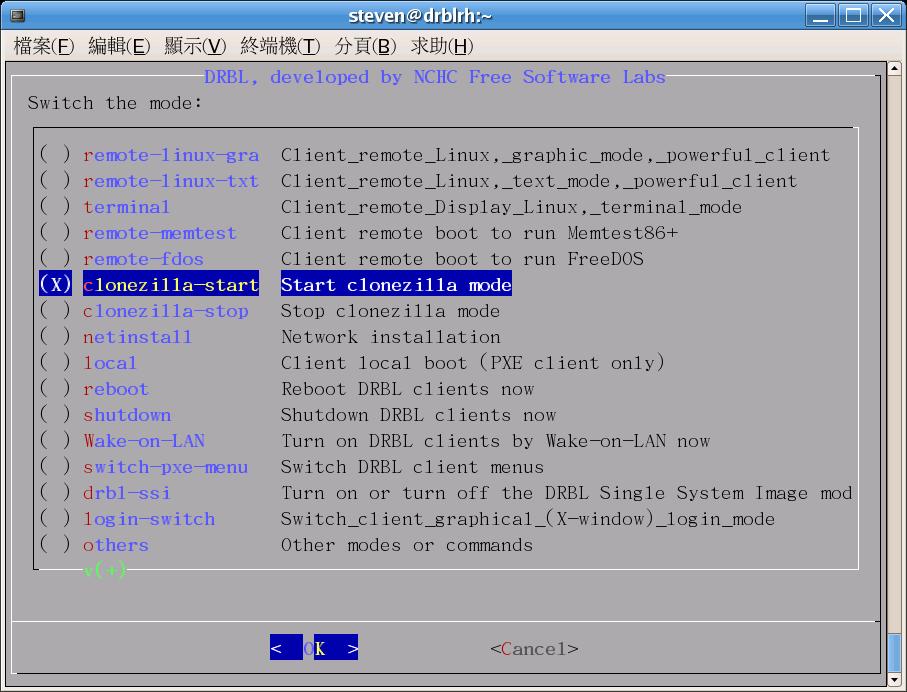
Features:
- Multiple file systems are supported:
- ext2, ext4, ReiserFS,ext3, reiser4, xfs, jfs, btrfs, f2fs and nilfs2 of GNU/Linux,
- FAT12, FAT16, FAT32, NTFS of MS Windows,
- HFS+ of Mac OS,
- UFS of FreeBSD, NetBSD, and OpenBSD,
- Minix of Minix, and
- VMFS3 and VMFS5 of VMWare ESX.
- Supports multiple 32-bit (x86) or 64-bit (x86-64) Operating systems
GNU/Linux, MS windows, Intel-based Mac OS, FreeBSD, NetBSD, OpenBSD, Minix, VMWare ESX and Chrome OS/Chromium OS
- The Master boot record and GUID partition table formats of hard drives are supported.
- The boot loader can be reinstalled.
- It can be booted on a BIOS or uEFI machine.
- Clonezilla takes all commands and options.
- One image can be restored to multiple local devices.
- AES-256 encryption for data security
FOG is a free disk imaging solution for Windows. It is an open source Linux-based tool. It is best implemented with a separate dedicated server for FOG only. It is freeware with a GPL license. It provides more than just imaging; it is a complete network management solution.

Features:
- All basic imaging and cloning features.
- Scheduling of imaging tasks with option to automatic shut down the computer
- FOG supports multi-casting.
- Imaging and deploying of the image to other computers
- It provides user support through a community forum.
- Installation of OS is possible using FOG.
- Partition and full disk imaging
- It is also used for disk wiping.
- It allows resizing the disk partition and disk volume.
- Provides security through anti-virus
DoClone is a free cloning software written in C++ for disk imaging of GNU/Linux systems. It allows a LAN network to transfer data within computers. This tool is mostly used in offices or schools to manage the GNU/Linux installation.
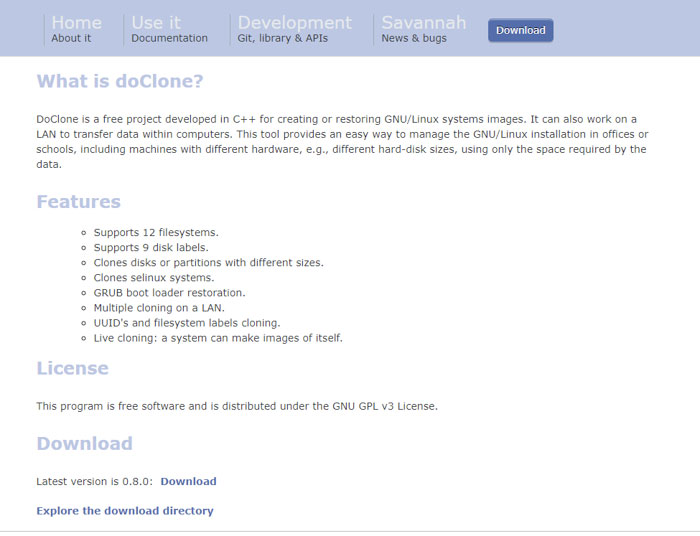
Features:
- It supports 12 file systems.
- It supports 9 disk labels.
- It is compatible with various file formats-ext 2, ext 3, ext 4, FAT 16, FAT 32, and others.
- Live cloning: a system can make images of itself.
- Clones selinux systems.
- Clones disks or partitions of different sizes
- GRUB boot loader restoration.
- Multiple cloning on a LAN.
- UUID's and file system labels cloning.
- It is distributed under the GNU GPL v3 License
- It can create a 40 GB disk and store it in a 20 GB disk.
Partclone is a free disk imaging/cloning software that provides imaging and cloning services and partition facilities. Partclonesupports, hfs+, ReiserFS, reiser4, ext2, ext3, ext4, btrfs, vmfs3, vmfs5, xfs, jfs, ufs, ntfs, fat(12/16/32), exfat, f2fs, nilfs.
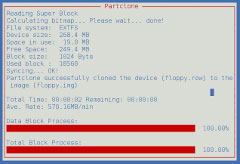
Features:
- Partclone provides services to back up and restore partition blocks.
- By using the existing library, it provides for greater compatibility of the file system.
- Its goal is to provide support to all major file systems.
- Partclone is an image engine.
- It saves imaging or restoring an image to a partition.
- It is used to clone devices.
- Supports advanced administrators
- Its rescue mode skips bad blocks and images, only the functional blocks for the partitions.
- The program is a solution to save a bad disk.
- Lists all used blocks as domain files
- It is a fast and smart software.
- All commands are in text mode.
- All back-up blocks are verified by the program.
- It is to make sure the data are correct.
- You could check the usage docs to get more information.
Mondo Rescue is a back-up software licensed under GNU/Linux server. It can recover
CD-R, DVD-R[W], CD-RW,], NFS, DVD+R[W, or hard disk partition. It is a useful disaster recovery software, and in case of data loss, it will let you in recovering all of your data. Used by companies such as IBM, Lockheed-Martin, HP, Siemens, the US Dept of Agriculture, and many more, this is a very reliable free data cloning and data recovery software.

Features:
- Mondo supports LVM 1/2, ext2, ext3, RAID, ext4, JFS, XFS, ReiserFS, VFAT, and can support additional filesystems
- It supports hardware raid controllers and software raid controllers.
- It supports BIOS and UEFI boot modes.
- Mondo runs on all major Linux distributions (Fedora, RHEL, OpenSUSE, SLES, Mageia, Debian, Ubuntu, Gentoo
- You may even use it to back-up non-Linux partitions
- All cloning features
- Fast and reliable
- Secure and safe data cloning
- Protected data
- Create back up of multiple files and folders
- Partition management
It is a free software for disk imaging and disk cloning. AOMEI Backupper Standard serves your back-up and recovery needs. This simple tool lets you do all disk imaging tasks intuitively. It works with all versions of Windows-Windows 10, Windows 8.1/8, Windows 7, Windows Vista, and XP with free technical support.

Features:
- Create a disk image of your system to keep your operating system and applications safe.
- Back-up/Sync to USB flash drive, network share/NAS, cloud drive.
- It can be used to back-up full hard disks (HDD), SSDs, or partitions.
- Explore back-up image
- Compress back-up image
- Check back-up image
- Create Windows PE & Linux bootable media
- Schedule back-ups or syncs
- Create scheduled automatic back-ups
- Incremental/differential backups
- Clone a smaller hard disk to a larger one for disk upgrade,
- Clone HDD to SSD for better performance.
- Automatic file sync: The imaging or cloning can be scheduled at regular intervals from a source location to destination daily.
It is a free disk imaging and cloning software to take back-up of your data. It provides easy solutions for upgrading your hard disks or implementing new operating systems. It is a very secure and safe way to recover lost files. It supports back-up to hard disks and USB drives. Macrium Reflect 7 Free Edition can be downloaded for free use. In case of a partial or full disk loss, you can restore the entire disk.

Features:
- Creates an accurate image of the hard disk
- Browse back-up contents in Windows Explorer.
- Schedule back-ups.
- Boot your back-ups instantly.
- Restore non-booting systems
- Differential Images
- Direct disk cloning
- Create images of a live/running Windows OS
- In the paid version, it provides incremental back-ups
- It provides ransomware protection.
- Operating System back-up and restore
- Easy to use software and intuitive interface
- Back-ups whole partitions or individual files and folders
- It is fast, reliable and scalable software
This free disk imaging software is used for creating reliable imaging and systematic back-ups of your hard drive. It stores images in in XML file format. It allows integration with 3rd party tools. Its private version is free for home use. One has to buy an upgraded version for commercial use.

Features:
- All features of Disk imaging are available
- Drive image XML takes back up of logical drives and partitions.
- Users can browse for images and extract files
- It lets the user restore the back-up on the same drive or on other
- The program can work all file formats such as FAT 12, 16, 32, and NTFS.
- Schedule automatic back-up
- It uses Microsoft's Volume Shadow Services (VSS) to create images.
- It is compatible to work with Windows XP, 2003, Vista, Windows 7, Windows 8, Windows 10.
Easeus is a free disk cloning software that lets you clone your drives, floppy disks, and USBs. In its free version, it provides all System/file/disk back-up & recovery Disk clone. For more features, one has to upgrade to its paid versions. It is one of the best software in the Disk cloning category. Available in 160 countries, Easeus claims to have satisfied 2,00,000,000 customers to date. Home users, organizations, academic users, IT admins, professionals, technicians, service operators, consultants, and enterprises can use the software.
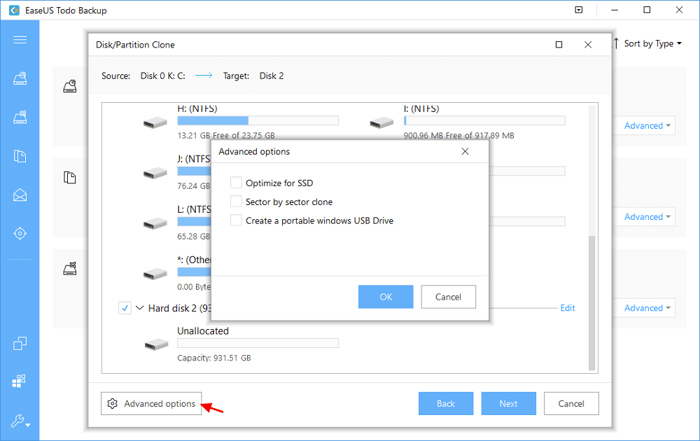
Features:
- All basic data cloning features
- Back up of HDD/SDD, partition or full disk volume
- It also allows disk imaging
- Disk and partition back-up
- Users can back up the entire OS
- Scheduling of data back-up is enabled
- It clones disk partition sector by sector
- Recovers deleted data or the whole system if required
- Allows full, incremental and differential back-ups
- Makes boot disk to install OS
- Full system back-up when the system is running
- Block-level disk imaging technology
We have also included one very popular Disk Imaging Software-Acronis Disk Director.
Acronis Disk Director
Acronis Disk Director 12.5 version is a popular disk imaging software that offers the safest way to create back-ups for your work data. It has a set of powerful tools to optimize your disk usage and secure your data from any glitch. It lets the user store different file systems and OS on the same disk. Users can create and manage various disk partitions. It supports all editions of Windows and IoT Enterprise editions.

(Source-Acronis Disk Director)
Features:
- Create copies of files and disk data.
- Resize the files and data volume.
- Split or merge disk volume
- Even the complex operations are accessible through its simple, intuitive interface
- Formatting of all file types FAT16, FAT32, NTFS, Ext2, Ext3, Reiser3, Linux, SWAP can be done.
- It lets users clone files from one disk to another. Applications, Operating systems, and even system preferences can be migrated from one drive to the other.
- The partition creating a module is very simple. It has step by step guidance and labels to help users to create partitions of their hard drives.
- Lost data volumes can be recovered quickly. Data loss due to hardware malfunction, malware, or accidental deletion can be restored back.
- Converting of disks from basic disks to dynamic disks is possible through this software.
- It assists you in creating a boot disk. The bootable media disk can launch your system from a CD/DVD or USB drive. This feature works even when there is no OS installed. It also supports Windows 10 pre-installation environment.
- The browsing feature allows searching detailed information about hard disk partitions and file systems.
- The editing capabilities of this software are useful when modifying your disk.
Conclusion:
Today technology is evolving at speed never witnessed before. Up-gradation and updates in both hardware systems and software capabilities have become a norm. Companies have to stay abreast of this by constantly monitoring their own systems and then timely upgrading the same. Companies can't even afford a slow hard disk that takes time to install data. When it comes to technology, the transition is from hours to minutes, minutes to seconds, and seconds to nanoseconds. For instance, many stock market companies spend millions of dollars just to be ahead in nanoseconds in receiving the ticker information. They can't afford any glitch, downtime, or loss of data. Their servers must always be running. There should be multiple back-ups available instantly.
Disk imaging and Disk cloning software play a vital role whenever companies need to update their systems. As new hardware and software installation process come with its own risks, it is always prudent to first take a back-up of everything that you have. In case of any installation errors or failure, the back-up is the only way to help you restore all systems in the status quo. In short, businesses cannot afford the grave mistake of not investing in such technologies and software.
Businesses and companies can use any of the Disk Imaging software discussed in this blog. Do share your opinion and insight about the article in the comments section below. If you have used any of the free and open-source Disk imaging Software mentioned above, then do share your feedbackwith us.
If you wish to refer to any other disk imaging software or any other software category other than disk imaging software, then do look at our software directory.

